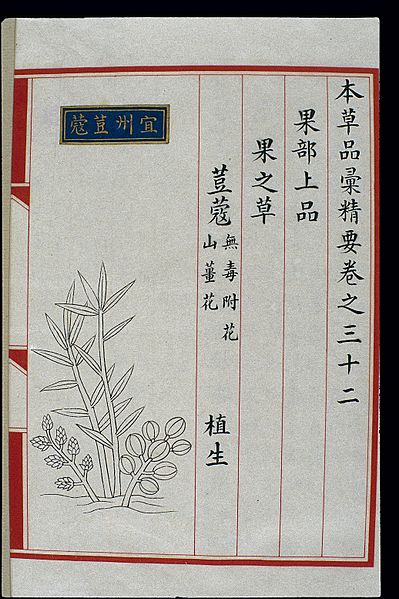Image: Chinese Materia Medica illustration, Ming; Cardamom of Yizhou Wellcome L0039306

Description: Traced copy of an illustration fromBencao pinhui jingyao(Materia Medica Containing Essential and Important Material Arranged in Systematic Order, completed 1505), in red and black ink. In 1503, the Ming emperor Li Zong put imperial physician Liu Wentai in charge of compiling a new herbal (bencao). The resulting work, whichran to 42 volumes, contained entries on 1815 pharmaceutical plants and other substances, with 1358 full-colour illustrations by artists including Wang Shichang. It was completed in the spring of 1505. However, in the summer of that year, The Emperor contracted a fever, which unsuccessfully treated by Liu Wentai, proved fatal. As a result Liu Wentai was banished from court, and the herbal was not allowed to be engraved or published. The original manuscript was preserved in the imperial palace, where only a select few officials were allowed to consult or copy it. The exemplar held in the Library of the China Academy of Traditional Chinese Medicine) is a traced facsimile made in the Ming (1368-1644) period by an unknown hand.This is a botanical illustration of cardamom (doukouorcaodoukou) from Yizhou [now in Guangxi province], showing the appearance of the plant.Bencao pinhui jingyaostates: Cardamom is first cited as a medicinal substance inMingyi bielu(Additional Records of Famous Physicians). The leaves of the plant resemble Alpinia japonica (shanjiang) or Pollia japonica (duruo), the roots resemble Alpinia officinarum (gaoliangjiang), and the fruits resemble pomegranates. Cardamom is pungent in sapor and warm in nature. It has the effect of warming the centre and dispersing cold; moving Qi and drying up dampness; halting vomiting and alleviating pain. It can be used to treat cold-damphuoluan(cholera and similar illnesses), cold pain in the stomach, nausea and retrograde Qi (ou'e qi ni), etc. Ink drawing 1505 By: Wang Shichang et al. (Ming period, 1368-1644)
Title: Chinese Materia Medica illustration, Ming: Cardamom of Yizhou
Credit: https://wellcomeimages.org/indexplus/obf_images/4c/7f/755a4901ab6599f973fe7fcd5002.jpg (hi-res image) Gallery: https://wellcomeimages.org/indexplus/image/L0039306.html Wellcome Collection gallery (2018-03-28): https://wellcomecollection.org/works/e3vekc6t CC-BY-4.0
Author: Wang Shichang et al. (Ming period, 1368-1644)
Usage Terms: Creative Commons Attribution 4.0
License: CC BY 4.0
License Link: https://creativecommons.org/licenses/by/4.0
Attribution Required?: Yes
Image usage
The following page links to this image:

